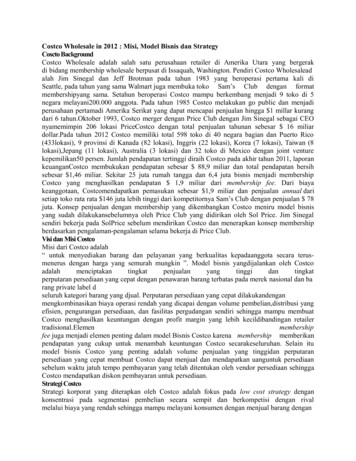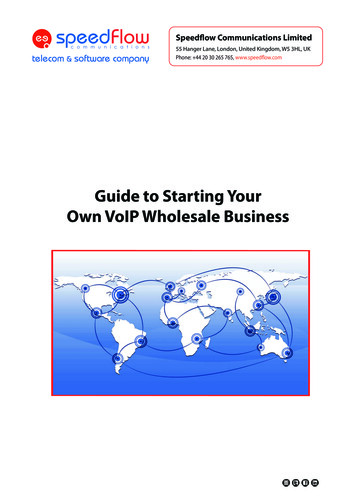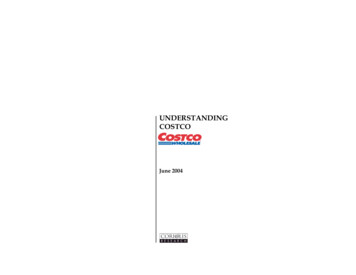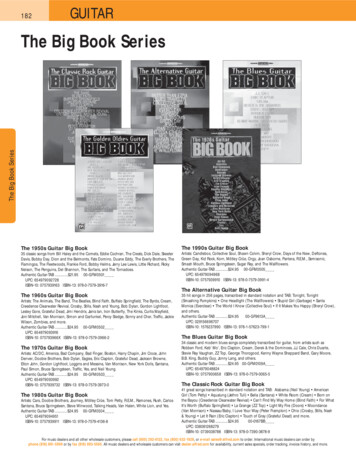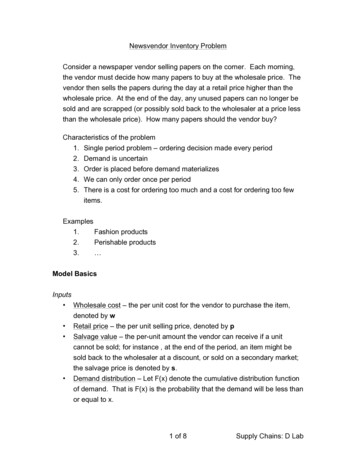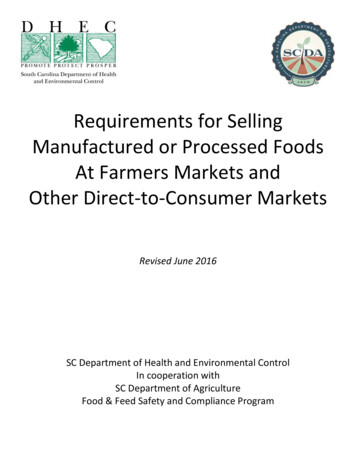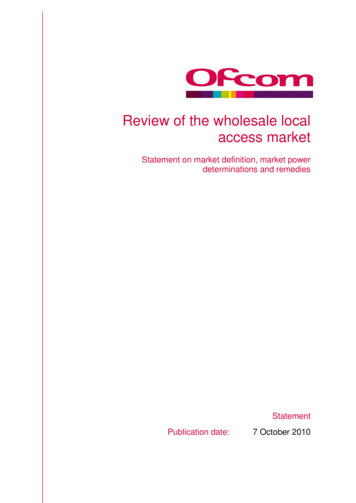
Transcription
Review of the wholesale localaccess marketStatement on market definition, market powerdeterminations and remediesStatementPublication date:7 October 2010
Review of the wholesale local access arket definition174Market power assessment375General remedies436Specific access remedies (1): LLU, fibre access, SLU737Specific access remedies (2): Physical Infrastructure Access8Specific access remedies (3): Virtual Unbundled Local Access 1249Specific access remedies (4): overall conclusions15110Legal tests for specific access remedies17511Next steps188Annex100Page1Market review process1912Legal Instrument1993Market definition methodology2314PIA reference offer requirements2405Glossary243
Review of the wholesale local access marketSection 11 SummaryOverview1.1Broadband is increasingly central to the lives of UK consumers and the success ofbusinesses. It allows consumers to access and interact with a wide range of contentand services and allows businesses to exploit new market opportunities and moreefficient operating models. Competition has driven the success of the currentgeneration of broadband services. This has been shaped by regulation and theavailability of local loop unbundling, which has allowed communications providers tocompete using regulated, wholesale inputs from BT. The result has been greaterchoice, innovation, lower prices and high levels of broadband adoption.1.2The increase in the number of consumers using their broadband connections foractivities such as downloading or streaming videos and music is, however, beginningto test the limits of current broadband networks. Equally, businesses and serviceproviders are looking to deliver a wider range of content, applications and servicesover broadband. Super-fast broadband 1 will have a key role in addressing theserequirements and thereby delivering significant benefits to UK consumers andbusinesses.1.3One of the main challenges facing Ofcom is to adapt the existing regulatoryframework to reflect the emergence of super-fast broadband. Over the past two yearscommercial investments in next generation access (“NGA”) networks have resulted insuper-fast broadband being made available to nearly half of all UK households.However, competition in the provision of super-fast broadband services remains in itsinfancy. To support the future development of the market, it is essential that thereshould be a clear regulatory framework designed both to promote competition and tosupport continued investment and innovation.1.4This document sets out the conclusions of our review of the UK market for WholesaleLocal Access (“WLA”) and is intended to establish such a framework. We have foundthat BT continues to have significant market power (“SMP”) in the UK market forWLA services 2, and concluded that access to BT’s local access network remainscritical for those companies seeking to compete in the delivery of downstreamservices such as broadband and traditional voice services. On the basis of thatfinding, we have imposed a number of regulatory obligations on BT, designed tosupport investment and competition in super-fast broadband, as well as in currentgeneration services.1.5The new regulatory model rests on the following core elements:12 Virtual Unbundled Local Access (“VULA”), which will allow competitors to deliverservices over BT’s new NGA network, with a degree of control that is similar tothat achieved when taking over the physical line to the customer; Physical Infrastructure Access (“PIA”), which will allow competitors to deploy theirown NGA infrastructure between the customer and the local exchange, usingBT’s duct and pole infrastructure, to provide broadband and telephony; andUsually taken to mean broadband with download speeds greater than 24Mbpsexcluding the Hull area1
Review of the wholesale local access market Local Loop Unbundling (“LLU”) which we expect will continue to provide a basisfor competition in current generation services, allowing competitors to physicallytake over (or share) BT’s copper lines between the customer and the localexchange.1.6We expect the new regulatory remedies (VULA and PIA) to be used in differentcircumstances: VULA is likely to be the most attractive for communications providers(“CPs”) where BT has already upgraded its local access network; PIA will beattractive to companies wishing to address market opportunities in advance of BTand may also be of particular interest to companies wishing to provide service inlocations which may be in receipt of public funding support.1.7These remedies will be complemented by other measures – such as Sub-loopUnbundling (“SLU”), charge controls for LLU but greater freedom for BT in the pricingof VULA services – designed to promote competition, protect customers and alsobalance the incentives for companies facing what remain risky investments.1.8Finally, we have extended the remit of the Office of the TelecommunicationsAdjudicator (“OTA”) to include both of the new remedies, VULA and PIA. The OTA’scontribution proved particularly important in facilitating the emergence of competitionin current generation broadband and we anticipate that it will play an equallyimportant role in respect of super-fast broadband.1.9We consider that the decisions we are taking today, and the regulatory products thatwill be available to BT’s competitors as a result, are consistent with the Government’sapproach to encouraging the roll-out of next generation broadband. PIA and SLUhave the potential to be used to extend the reach of super-fast broadband, potentiallyin combination with public funding at a UK or EU level. This would support theGovernment’s aim to introduce superfast broadband in remote areas at the sametime as in more densely populated areas.1.10The Government is currently consulting on the implementation of the new EUtelecommunications framework, which amongst other things will give Ofcomadditional powers to encourage the sharing of telecommunications infrastructure. TheGovernment is also consulting on the scope for infrastructure-sharing by nontelecommunications utilities (e.g., sewage, gas and electricity). We believe theintroduction of the PIA remedy will complement any initiatives that flow from thesedevelopments.The market review1.11This document sets out our analysis of the state of competition in the WholesaleLocal Access (WLA) market, and the measures that we are taking to promotecompetition in that market. We published our proposals on these issues in March2010 (“the consultation document”) 3.1.12These decisions will have significant implications for consumers. While the WLAmarket directly concerns services provided between different CPs, decisions taken inthe context of this market review will ultimately affect the prices, choice andavailability of critically important services in the retail market, such as currentgeneration broadband and traditional voice services. Our decisions also matter3Review of the wholesale local access market, consultation on market definition, market powerdeterminations and remedies - /2
Review of the wholesale local access marketbecause they are intended to promote competition and investment in new super-fastbroadband networks, in the important early development stages of those networks.1.13The WLA market concerns fixed telecommunications infrastructure - the physicalconnection between a consumer’s premises and the local telephone exchange. Thisconnection is needed to support fixed line services such as voice calls andbroadband internet access. The cost of this connection therefore affects the pricesthat consumers pay for those services. Also, if this connection fails then consumers’services will fail. The WLA market is therefore critical to all fixed line services.1.14In reviewing this market we have assessed the extent of competition in the supply offixed telecommunications connections. The ultimate goal of this review is to protectconsumers’ interests by using regulation to promote competition and choice in thedelivery of fixed line telecommunications services. This will help to ensure thatconsumers do not have to pay excessive prices for those services, and that theybenefit from innovation and investment.1.15We periodically review various markets in accordance with both European anddomestic legal requirements, including the Communications Act 2003 (“the Act”). Themarket review process is divided into three parts. First, we define the scope of themarket that we are assessing (both the products in the market and its geographicscope). Then we assess whether any CPs have a position of SMP, which in simpleterms means the power to influence markets to a significant degree in a way thatcould harm consumers 4. Then, if any CPs have SMP, we assess which regulatoryremedies might need to be imposed to address that SMP.1.16In tandem with this WLA market review, we are currently reviewing the relatedWholesale Broadband Access (“WBA”) market, and have now published twoconsultation documents on that market 5. Our WLA decisions should be viewed inconjunction with those in the WBA review in order to understand the overall impacton consumers.1.17The WBA market concerns the wholesale broadband services which are used byCPs to provide retail broadband services to business and residential consumers. TheWBA market therefore sits between the WLA market and the retail broadbandmarket. Regulation in the WBA market takes into account how much infrastructurecompetition exists (including as a result of regulation of the WLA market). Effectiveand sustainable infrastructure competition tends to give rise to the greatest benefitsin terms of the mix of lower prices and faster innovation. This is why we have beenreviewing these markets at the same time. The conclusions we reach in the WBAmarket review will take account of the decisions set out in this document.Summary of decisionsMarket definition1.18We conclude that the WLA services within this market are those based on copperloops, cable networks and optical fibre, at a fixed location. We conclude that the4Formally, SMP is defined as ‘a position of economic strength affording an undertaking the power tobehave to an appreciable extent independently of competitors, customers and ultimately consumers’5On 23 March 2010 - “the WBA consultation document” - http://www.ofcom.org.uk/consult/wba/, andon 20 August 2010 - “the second WBA consultation document” lesale-broadband-markets/. We expect to publishour final decisions in the WBA market by the end of 2010.3
Review of the wholesale local access marketmarket excludes WLA services based on mobile, fixed wireless and satellitetechnologies. We also conclude that WLA services for business and residential useare in the same market.1.19We conclude that there are two separate geographic WLA markets: The UK excluding the Hull area; and The Hull area.Market power assessment1.20Our SMP findings in the WLA market are as follows: BT has SMP in the UK excluding the Hull area; and KCOM has SMP in the Hull area.1.21One of the key reasons why we have concluded that BT has SMP is its high marketshare, which is 84 per cent 6. As we have concluded that the WLA market currentlyencompasses both current generation access (“CGA”) and NGA networks, VirginMedia’s earlier NGA deployment does not in itself radically change its market share.Market shares are based on take-up, not deployment (although the two are obviouslyrelated).1.22As we consider that there is SMP in both of these markets, we have decided toimpose regulatory requirements on BT and KCOM to address the identifiedcompetition problems. Under the legal framework governing our proposals, it is onlypossible to impose obligations on those CPs that have SMP in the relevant market.We therefore are not imposing regulatory obligations on any other CPs in thesemarkets – including Virgin Media.Remedies for market power1.2364To address BT’s SMP, we are imposing a number of complementary regulatoryobligations (SMP remedies). BT will be required to provide other CPs (“OCPs”) withaccess to its network in the following ways: Local Loop Unbundling (LLU): a successful remedy that is already in place, thisallows OCPs to physically take over (or share) BT’s existing copper linesbetween the local telephone exchanges and the customer premises; Virtual Unbundled Local Access (VULA): this will have to be provided by BTwherever it deploys its NGA network. VULA is intended to provide access to theNGA network in a way that is similar to how LLU provides access on the CGAnetwork. However, rather than providing a physical line, VULA will provide avirtual connection that gives OCPs a dedicated link to their customers andsubstantial control over the services provided; and Physical infrastructure access (PIA): like VULA, this is a new remedy. It will allowOCPs to deploy fibre in the access network using BT’s ducts and poles - either tosupport deployment of fibre-to-the-premises (“FTTP”) technology, or to supportdeployment of fibre-to-the-cabinet (“FTTC”) technology (by enabling a ‘backhaul’Of active access lines in the UK
Review of the wholesale local access marketconnection between street cabinets and the OCP’s network). BT has to producea draft reference offer (“RO”) for duct and pole access by mid-January 2011, witha view to launching a product by the middle of that year. BT will be obliged toprovide PIA services for the purposes of deploying of NGA networks to supportservices such as broadband, telephony and cable TV, but not, at this stage,leased lines. Further consideration will be given to extending the scope of theremedy to include leased lines in the next business connectivity market review,which is due for completion in 2012.1.24In addition, we have decided to continue a requirement on BT to provide SLU. Whilstthis is an existing remedy, it has so far only been used in very limited situations. Itallows OCPs to physically take over (or share) the part of BT’s existing copper linesbetween a street cabinet and the customer premises. This remedy will allow OCPs todeploy FTTC technology where they consider this to be economic.1.25Based on these specific access products, OCPs will be able to use BT’s networkinfrastructure to develop their own services to offer to consumers, thereby loweringbarriers to entry and investment. VULA should also support competition in(downstream) broadband and voice markets by providing BT and OCPs with anequivalent input for developing those services. We expect BT’s downstreambusinesses to use VULA as an input when providing downstream services.1.26At this point, we consider that VULA is likely to be the main basis for NGAcompetition over BT’s network, to supplement the continuing effectiveness of LLU,over at least the next four years. Our economic analysis suggests that VULA is verylikely to be the most cost-effective NGA remedy and the remedy most likely toemulate the level of competition currently delivered by LLU. However, we think thataccess to BT’s ducts and poles, and to a lesser extent SLU, could also play a part insupporting competition, as well as investment in NGA. Partly, this is because VULAwill only be available where BT deploys its NGA network.1.27We have concluded that prices for LLU, PIA and SLU must be related to the cost ofproviding them 7. However, we have decided not to regulate the prices of theproduct(s) that BT provides under its VULA obligation. We consider that thisapproach will give BT the flexibility to price its VULA services according to emerginginformation on the demand for, and supply costs of, NGA services. At the same time,the prices of these services will be constrained by the availability of currentgeneration broadband services and by competition from services provided over cableTV network infrastructure.1.28In addition to requiring the specific products referred to above, we have imposed aset of general access remedies on BT, all of which apply to it currently in this market.These include a requirement to provide network access, an obligation to notdiscriminate unduly when providing services, various transparency measures, and arequirement to keep separate accounts for different services (to support effectiveregulation). For VULA, we have decided to apply a strict interpretation of the noundue discrimination obligation, to reflect VULA’s importance for competition andbecause, as a new product, it should be possible to provide VULA in a nondiscriminatory manner without incurring inefficiencies.7Based on the long-run incremental cost of provision, including an appropriate element of BT’scommon costs. Charges for LLU are currently controlled under a 4-year arrangement that ends inMarch 2011. We will be consulting in the near future on proposals for a new LLU charge control.5
Review of the wholesale local access market1.29For KCOM, we have decided to maintain the general access remedies whichcurrently apply to it in this market 8. These include a general requirement to providenetwork access and a no undue discrimination obligation. We have also introduced anew general requirement for KCOM to publish guidelines on its process for handlingrequests for new network access. This new obligation is intended to provide greatertransparency and information to OCPs who are considering entering the market inHull. However, we are not at this stage requiring KCOM to provide any specificaccess products, such as access to its duct and pole infrastructure. This reflects thecontinuing limited interest among CPs in competing in the Hull area. In thesecircumstances, we do not consider that it would proportionate to require KCOM todevelop such products, the costs of which would need to be recovered throughhigher prices for KCOM’s customers.Developments since the consultation document1.30In response to our proposals, we received substantive inputs from a number ofstakeholders. Most stakeholders agreed with our market definition and SMPproposals. The key issues raised concerned the detailed nature of the remedies onBT, especially the design of VULA and PIA and the speed with which they will beimplemented.1.31Since the publication of the consultation document, there have also been a numberof other developments, including modifications to the access products proposed byBT. These developments have largely reinforced the case for the proposals set out inthe consultation document. They include:8 The higher targets announced by BT for its NGA deployment, to 2015. Weconsider that the main impact of this change on SMP remedies is likely to be agreater level of interest in using VULA relative to other remedies. However, eachof the remedies that we are imposing will still have a role, for example becausePIA (and SLU) could be used in any given area before BT deploys NGA there; The improvements made by BT to its Generic Ethernet Access (“GEA”) NGAwholesale products for CPs, through which it intends to comply with its VULAobligations. For the FTTC variant, Openreach has agreed to trial a CP-installedproduct in the near future. For the FTTP version, Openreach will now adopt an‘open ATA’ approach 9, which should be more pro-competitive as it will giveinterconnecting CPs a greater degree of control over the voice services that canbe provided using GEA; Positive steps in the development of access to BT’s local network infrastructure.BT committed to offering access to its duct and pole network, and began detaileddiscussions with OCPs to define their requirements and develop its RO. Inaddition, BT has held a number of discussions with OCPs in response to a recentStatement of Requirements for SLU services; The publication by the European Commission (“the Commission”) of its finalRecommendation on regulated access to NGA networks (“the NGAin the Hull Area onlyThe term “ATA” refers to a voice analogue telephone adaptor. BT has chosen to embed this into thenetwork termination equipment (“NTE”) that is currently a necessary part of its FTTP GEA product.96
Review of the wholesale local access marketRecommendation”), which is highly relevant to our decisions on SMP remedies 10.We have been monitoring the evolution of the Recommendation for some time,and have taken utmost account of the final version in reaching our conclusions;and 1.32The incoming Government’s announcement of measures to encourage roll-out ofnext generation broadband in the UK. It is currently consulting on the scope fornon-telecommunications infrastructure to be shared to facilitate broadbandnetwork deployment 11. It has also indicated that it will seek to introduce super-fastbroadband in remote areas at the same time as in more populated areas (whichmay involve both fixed and wireless access solutions). We consider that ourdecision to require PIA is consistent with these objectives and that (together withdevelopments in SLU) it will make it easier for OCPs to deploy their own NGAnetworks where BT has not yet done so, or may not intend to do so.In most respects, our decisions reflect the proposals set out in the consultationdocument. We would, however, highlight two noteworthy changes, which takeaccount of the responses received: PIA: we have brought forward the deadline for the draft RO for pole access, fromsix months to just over three months, harmonising the timescale with the ductaccess RO; VULA pricing: we provide some further details about how we would expect toapproach any concerns that are raised about the margin between BT’s prices forVULA and its prices for retail services based on VULA.Next steps1.33There are a number of important practical issues to consider in relation to theimplementation of the new VULA and PIA remedies. On VULA, we have set out anumber of high-level characteristics, and we will need to be reassured that BT’sVULA-based product set is fully compliant with them. In terms of product specificationand implementation, further cross-industry discussion is required to identify clearlythe requirements.1.34Further industry discussion is also needed on the details of the PIA products that BTshould offer. The obligation requires BT to produce an initial RO for duct and poleaccess, describing the services to be made available, within just over three monthsfrom the publication of this statement. Significant OCP involvement will be needed, totake BT’s proposal forward.1.35This detailed implementation work will benefit greatly from the participation of theOTA. We have therefore extended the OTA’s remit to include PIA and VULA, soallowing it to take a view of BT’s developments across all WLA remedies. Building onthe OTA’s successful role in promoting the development of LLU, we believe that this10Commission Recommendation on regulated access to Next Generation Access Networks (C(2010)6223), 20 September 2010 http://ec.europa.eu/information society/policy/ecomm/doc/library/recomm guidelines/nga/en.pdf11Broadband deployment and sharing other utilities infrastructure, July 2010 - The Department forBusiness, Innovation and Skills (‘BIS’) - at open7
Review of the wholesale local access marketwill help clarify requirements and planning for all stakeholders and help promotevibrant and effective competition in the development of new super-fast broadbandservices.1.368Beyond implementing the obligations in this market review, we will continue our workto improve the environment for competition and investment in NGA networks. In thenear future, we expect to issue updated guidance on the regulation of new build fibredevelopments. We may also look more broadly at the scope for extendinginfrastructure access to other networks, under powers contained in the recent updateto the new EU Communications Framework, which is due for implementation in theUK by May 2011.
Review of the wholesale local access marketSection 22 IntroductionPurpose of this statement2.1This statement sets out our conclusions on how we should regulate the wholesalelocal access (WLA) market over the next four years. In doing so, it considers the levelof competition that exists, and is anticipated in this economic market.2.2Put simply, the WLA market covers fixed telecommunications infrastructure,specifically the physical connection between end users’ premises and a localexchange. This connection is needed to support fixed line services, such astelephony and broadband. The charge for this connection therefore affects the pricesthat end users pay for their services. Equally, if this connection fails then end users’services will fail. The WLA market is therefore critical to all fixed line services.2.3Market reviews are carried out to assess the competitive conditions that exist in amarket and, where there is not a sufficient level of competition, impose obligations(remedies) that address any potential negative effects that arise from the lack ofcompetition. The ultimate goal is to ensure that customers enjoy sufficient choice andbenefit from the lower prices and increased product innovation that arises fromcompetition. In reviewing the WLA market, we have sought to establish whether thereis sufficient competition in the supply of fixed telecommunications connections.2.4The requirement to conduct market reviews, and the processes to follow when doingso, are set out in various legislation and guidance at a European and a national level(see paragraph 2.25). Within this framework, we nevertheless have significantdiscretion over the decisions that will best support competition and serve theinterests of citizens and consumers in the UK’s specific circumstances.The consultation process2.5We consulted on proposals in this market in March 2010. In reply, we received a totalof 27 responses. The majority of these were from communications providers. Wealso received a range of responses from other stakeholders, including industrygroups, local government, an Ofcom Advisory Committee, and a member of thepublic.2.6Responses predominantly focused on the specific access remedies that we proposedin the consultation document – VULA, PIA, LLU and SLU. However, we also receivedviews on our approach to market definition and our assessment of significant marketpower (SMP). The non-confidential responses (which are a clear majority) can beviewed on our website 12.Strategic context for this market review2.712In undertaking a market review, we consider the potential market and technologicaldevelopments in the next few years, so that our decisions reflect those developmentsas well as current competitive conditions. In this market review, a forward look isSee /?showResponses true9
Review of the wholesale local access marketparticularly relevant because the next few years will be the early roll-out period forNGA networks, which will enable the delivery of ‘super-fast’ broadband services.2.8Super-fast broadband is generally taken to mean broadband products that provide amaximum download speed that is greater than 24 Mbit/s. This threshold is commonlyconsidered to be the maximum speed that can be supported on current generation(copper-based) networks 13. Of course, the actual speed experienced by consumersdepends on factors such as distance from the local exchanges 14. To achieve higherspeeds than 24 Mbit/s, CPs would need to use alternative technology, based onproviding a connection over optical fibre some or all of the way to the customer.2.9We have been considering for some time, in consultation with many stakeholders,the appropriate regulation to promote investment and competition in NGA. A keyoutput of that work was our March 2009 strategic statement (“the Super-fastBroadband statement”) 15. At the same time as following the standard market reviewprocesses, this market review represents a major part of implementing the strategicapproach that we have developed.2.10Currently, evidence suggests that, where deployed, NGA is being used for videobased applications, including broadcast-quality TV. NGA is also likely to be importantin providing broadband access to multi-PC homes. NGA could also deliver distinctbenefits to specific groups of end users, such as older and disabled people 16.Nonetheless, considerable uncertainty remains regarding the range of services thatwill be provided over super-fast broadband. Experience from overseas deploymentsshows that there is experimentation in the types of services being offered. Weconsider that it is important to take a regulatory approach that is flexible enough toallow for experimentation in innovative new products and services, whilst at the sametime preventing consumer detriment as a result of firms exploiting market power.2.11BT and Virgin Media are both now offering retail services that are based on NGAdevelopments. Virgin Media has been offering super-fast broadband services sincethe end of 2008. In January 2010, BT’s retail business announced the prices that willbe charged for its ‘BT Infinity’ super-fast broadband service that will be available as itupgrades its existing access network. It added a further, cheaper, Infinity option inAugust 2010.2.12The current status of NGA deployments is as follows: 13Virgin Media has been offering super-fast broadband services since the end of2008, and it completed the rollout of a 50 Mbit/s capability across its entirenetwork in Q3 2009. Its network covers 46 per cent of UK premises, although itsmarket share is currently only 16 per cent of fixed access connections in the UK(CGA and NGA lines combined). In June 2010, Virgin Media reported 74,000subscribers on its 50 Mbit/s broadband service. It also announced plans to launchUsing “ADSL2 ” technologyOfcom, UK broadband speeds 2009, 28 July rts/broadband speeds/broadba
Local Access ("WLA") and is intended to establish such a framework. We have found that BT continues to have significant market power ("SMP") in the UK market for . our final decisions in the WBA market by the end of 2010. Review of the wholesale local access market . 4 market excludes WLA services based on mobile, fixed wireless and .

